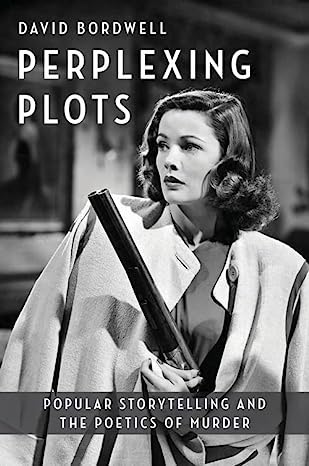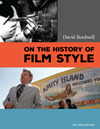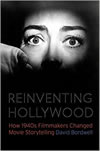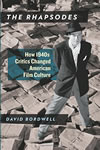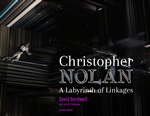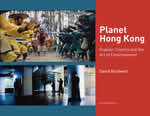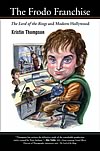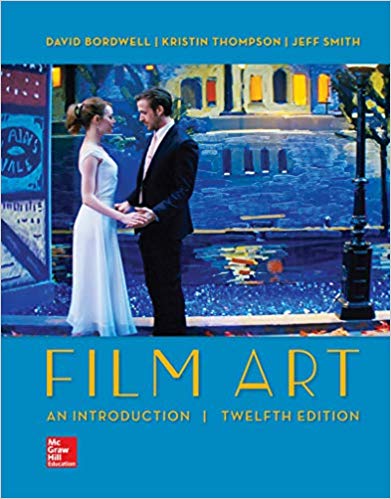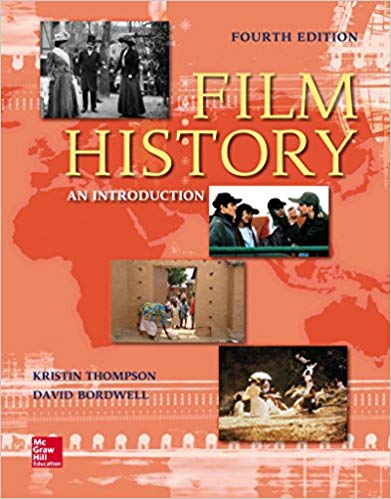
Wednesday | May 8, 2019
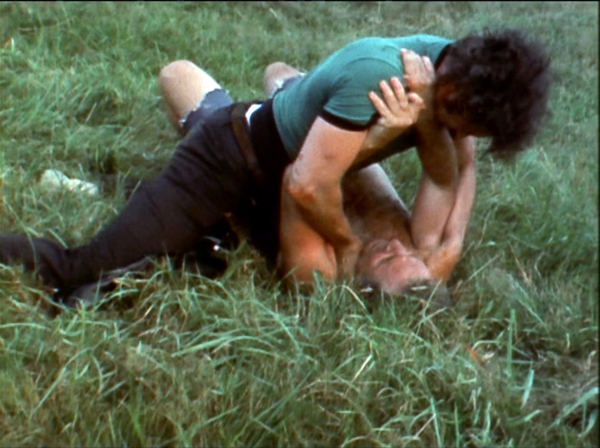
Maidstone (1970).
DB here:
Did you ever want to beat up Norman Mailer? The impulse must have flitted through the minds of many who paged through his work, saw him on TV, or encountered him swaying pugnaciously at a party. Rip Torn took the opportunity. One day in 1968, he whacked Mailer with a hammer and started to strangle him. As the distinguished author tried to bite off Torn’s ear, Mailer’s wife leaped into the fray and his children shrieked with fear.
This scene, totally unscripted, appears in Mailer’s film Maidstone (1970) and opens J. J. Murphy’s new book Rewriting Indie Cinema: Improvisation, Psychodrama, and the Screenplay. Nothing could better prepare us for his exploration of the traditions–and sometimes jarring consequences–of spontaneous performance in modern American movies.
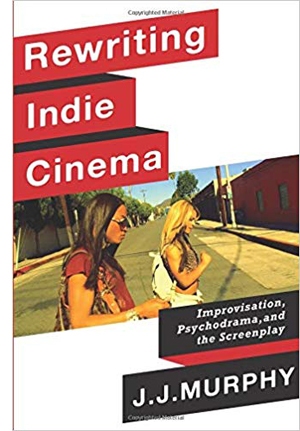 I couldn’t have predicted that J. J., who was in grad school with Kristin and me, would turn to research. He began as part of the Structural Film movement, achieving wide renown with Print Generation (1974) and (my personal favorite) Sky Blue Water Light Sign (1972). After he was hired here at Wisconsin, he rejuvenated our production program and went on to make independent features: The Night Belongs to the Police (1982), Terminal Disorder (1983), Frame of Mind (1985), and Horicon (1994). I couldn’t have predicted that J. J., who was in grad school with Kristin and me, would turn to research. He began as part of the Structural Film movement, achieving wide renown with Print Generation (1974) and (my personal favorite) Sky Blue Water Light Sign (1972). After he was hired here at Wisconsin, he rejuvenated our production program and went on to make independent features: The Night Belongs to the Police (1982), Terminal Disorder (1983), Frame of Mind (1985), and Horicon (1994).
At the same time, he was teaching both production and screenwriting. His books reflect his deepening interest in the creative process of making a film outside the Hollywood system. His initial study, Me and You and Memento and Fargo: How Independent Screenplays Work (2007), focused on the principles of screenplay construction that emerged with US indie cinema. Then, in The Black Hole of the Camera: The Films of Andy Warhol (2012), J. J. offered the most complete analysis of this superb body of work. In the process, he opened up a new vein of exploration. The idea of psychodrama proved an exciting way of explaining the fascinating, awkward performances in films like Kitchen (1965), Vinyl (1965), and Bike Boy (1967).
Now the concept of psychodrama gets full play in an ambitious account of the changing role of improvisation in off-Hollywood cinema. What happens, J, J. asks, when filmmakers give up the screenplay? How do they construct a story, define characters, build performances? Rewriting Indie Cinema sweeps from the 1950s to recent films like The Rider and The Florida Project. By looking for alternatives to the fully prepared screenplay, it posits a fresh way of thinking about American film artistry.
Human life isn’t necessarily well-written
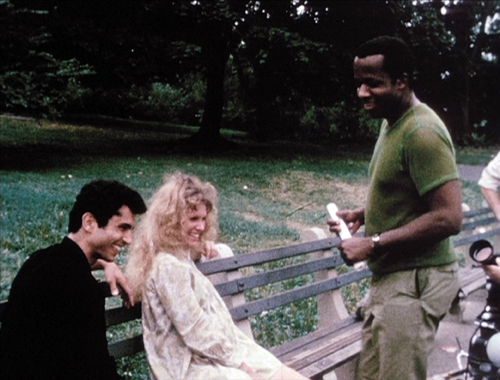
Symbiopsychotaxiplasm: Take One (1968).
To start off, J. J. proposes that we think of improvisation in a systematic way. Of course, the concept can be treated broadly. Even Hitchcock, we learn from Bill Krohn, improvised on the set much more than he claimed. But J. J. suggests that improvisation can be considered as a basic creative concept, a founding choice for art-making.
In the 1950s, many American artists began to embrace chance, accident, and personal expression. Abstract Expressionism, bebop, the Judson Dance Theater, Robert Frank’s snapshot aesthetic, and other tendencies valued spontaneity as both authentic self-expression and a challenge to conformist culture. The idea of spontaneity was carried into cinema by Jonas Mekas and fueled what became the New American Cinema of John Cassavetes, Shirley Clarke, and other filmmakers.
But the idea had deeper sources in another trend that J. J. painstakingly brings to light. The Austrian theater director Jacob L. Moreno developed in the 1920s what he called the Theatre of Spontaneity (Das Stegreiftheater). Performances consisted of purely improvised dialogue. When Moreno emigrated to America, he founded “Impromptu Theatre” in the same vein. His 1931 performance at Carnegie Hall was greeted by the New York Times with some disdain:
The first play, like the ones that followed, turned out to be a dab of dialogue uneasily rendered by its hapless players. . . . It became more and more evident that heavy boredom, rather than “forms, moods and visions,” were [sic] the product of the actors. Demanding wit above all else, the Moreno players lacked that essential as fully as the premeditation upon which they frown so heartily. The legitimate theatre, it can be reported this morning, is just about where it was.
Of course improvisation had already proven its worth in vaudeville and in jazz and other musical idioms. Today versions of Moreno’s “spontaneous theatre” flourish in comedy clubs.
Before coming to America, Moreno had discovered that improvisation had therapeautic functions as well. When a couple enacted the frustrations of their marriage, the audience was moved and Moreno was convinced that this “psychodrama” harbored artistic possibilities. Moreno’s wife Zerka called psychodrama “a form of improvisational theatre of your own life.”
J. J. shows Moreno’s pervasive influence on the postwar American scene. Psychodrama became one trend in social psychology, used to help prisoners, narcotics addicts, and even business executives. Woody Allen, Arthur Miller, and other artists were aware of Moreno’s work as well.
Drawing on Moreno but recasting him for film-related purposes, J. J. proposes a spectrum of improvisational options. There’s the completely improvised, ad-lib option, seen in Maidstone and much of Warhol’s work. Here the performers just make it up as they go, though with minimal framing of a situation. Then there’s the possibility of “planned” improvisation, in which there’s a story outline and more or less pre-set scenes. Sean Baker’s Tangerine (2015), for example, was made from a seven-page treatment that included only a couple of lines of dialogue. Then there’s the “rehearsed” option, in which the players collaborate to prepare the scenes and develop the characters, workshop fashion. In production the performers mostly stick to the “script” they’ve created. J. J. points to the films of Cassavetes as a clear case.
Any given film can mix these options, so that some scenes are planned roughly while others are purely ad-lib. And a filmmaker can explore the spectrum across several films, as Joe Swanberg has done.
Where does psychodrama come in? J. J. shows that any of the three points on the improvisation spectrum–pure, planned, and rehearsed–can yield performances that are based in the actual mental states and personal histories of the players. In our Cinematheque screening devoted to his book, Abel Ferrara’s Dangerous Game (1993) served as an example. Harvey Keitel invested his character, an intransigent film director, with the still simmering emotions he felt after his breakup with Lorraine Bracco. Meanwhile Ferrara set up scenes that would provoke Madonna, playing Keitel’s actress, to break character and reveal her immediate responses.
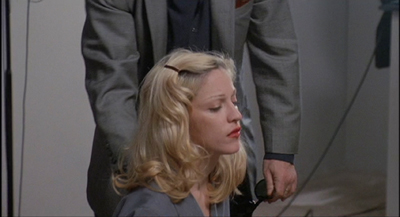
Ferrara wanted to attack Madonna’s celebrity image, and J. J. reads the aftermath to a rape scene in the film being made as projecting the star’s own stammering outrage at having been exploited.
Throughout the book, when improvisation becomes psychodrama, fiction moves closer to documentary. The last chapter examines how certain films considered documentaries, like Robert Greene’s Actress (2014) and James Solomon’s The Witness (2015), cross over into psychodrama from the other side, so to speak.
A detailed study of William Greaves’ Symbiopsychotaxiplasm: Take One (1968) shows how Greaves used psychodramatic techniques to create an even more complicated film-within-a-film than Dangerous Game. Two characters, Freddie and Alice, are played by five different pairs of actors, with all their scenes recorded by a bevy of camera and sound staff.
Greaves also incorporates self-criticism. When crew members object to the script, another participant remarks: “Human life isn’t necessarily well-written, you know.”
Given these conceptual tools, J. J. goes on to trace the production methods employed by a wide range of filmmakers, from Morris Engel in The Little Fugitive (1953) and Cassavetes in Shadows (1959) to Mumblecore and after. Through a mixture of film analysis and background research, he brings to light a vast variety of creative options that can bypass fully-scripted cinema.
Rewriting the unwritten
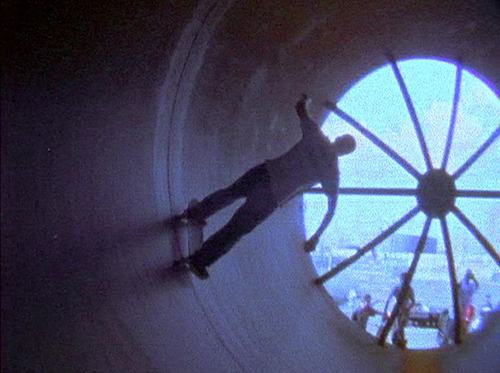
Paranoid Park (2007).
J. J.’s survey of production methods is embedded in a new historical argument about the shape of off-Hollywood filmmaking. The New American Cinema of the 1950s, which Mekas called “plotless cinema,” was wedded to a sense of realism. But it operated within limits. Cassavetes serves as a benchmark: “I believe in improvising on the basis of the written work and not on undisciplined creativity.” By balancing the planned with the impromptu, his films allowed for the actors to surprise one another. At the same time, Shirley Clarke’s Portrait of Jason (1967) showed how psychodrama could pass easily into documentary, exemplifying Erving Goffman’s theory that everyone is playing theatrical roles in everyday life.
This open approach to screenwriting and screen acting was explored by many filmmakers in the 1960s and a little after: not only the well-known Warhol and Mailer but also Kent Mackenzie, Barbara Loden, William Greaves, and Charles Burnett. J. J. examines all this work in admirable detail. I was especially happy to see that he includes Jonas Mekas’ The Brig (1964), the harrowing film that showed me, in my undergrad days, what the New American Cinema could do in filming a play.
By the time Ferrara made Dangerous Game, most independent filmmaking had moved away from improvisation toward more tightly scripted expression. J.J. traces the institutional pressures operating here. The Sundance Film Festival and PBS’s American Playhouse favored fully-planned projects compatible with the Hollywood standard. The Sundance Institute, launched in 1981, explicitly aimed to correct what was considered the two faults of independent production: screenplays and performances.
The success of polished work like sex, lies, and videotape (1989) and Pulp Fiction (1994) created new norms for American indie cinema. Director-screenwriters like Soderbergh, Tarantino, David Lynch, Hal Hartley, Todd Haynes, the Coens, and Todd Solondz were models for younger filmmakers. As J. J. points out, their screenplays were often published as part of the marketing of the films. Framing the new trend as dominated by the screenplay helped me understand why Bryan Singer, Doug Liman, Karyn Kusama, and other indie filmmakers who came up in the wake of this generation moved so easily to mainstream genres and big-budget projects.
But history plays strange tricks. In the 2000s, filmmakers who felt constrained by the demands of tight scripting began to try something else. J. J. pays special attention to Gus Van Sant, who after proving his commercial craft, made some films with varying degrees of improvisation: Gerry (2002), Elephant (2003), Last Days (2005), and Paranoid Park (2007). Some of the Mumblecore directors relied on screenplays, but the prolific Joe Swanberg adopted a free-form approach, to which J. J. devotes a chapter.
J. J. goes on to survey the work of Sean Baker, the Safdie brothers, Ronald Bronstein, and other directors who have revived the New American Cinema’s impulses in the digital age. He concludes:
Digital technology in effect, democratized the medium, allowing young filmmakers to revive cinematic realism precisely at a time when indie cinema was at risk of losing its identity. In the new century, the use of improvisation and psychodrama provided a sense of continuity with indie cinema’s roots.
J. J. retired from UW–Madison at the end of 2018, and last Saturday night he was honored at our annual screening of student projects. He has been a constant force for good in our department, and we owe him more than we can say. Among those debts is this outstanding contribution to US film studies.
The book’s title carries a double meaning. American independent cinema has been, at crucial periods, “rewritten” by filmmakers who relied on spontaneity rather than a cast-iron screenplay. At the same time, J. J.’s panoramic research in effect rewrites that history. I’m sure that other researchers will build on his wide-ranging arguments, which put the creativity of artists–filmmakers, performers–at the center of our concerns.
J. J.’s books join a cascade of recent work by other colleagues here at Wisconsin. This blog has highlighted Jeff Smith’s Film Criticism, the Cold War and the Blacklist (2014), Kelley Conway’s Agnès Varda (2015), Lea Jacobs’ Film Rhythm after Sound (2015), Lea’s and Ben Brewster’s enhanced e-book of Theatre to Cinema (2016), and Maria Belodubrovskya’s Not According to Plan: Filmmaking under Stalin (2018).
P.S. 9 May 2018: Thanks to Adrian Martin for correction of a misspelled name!
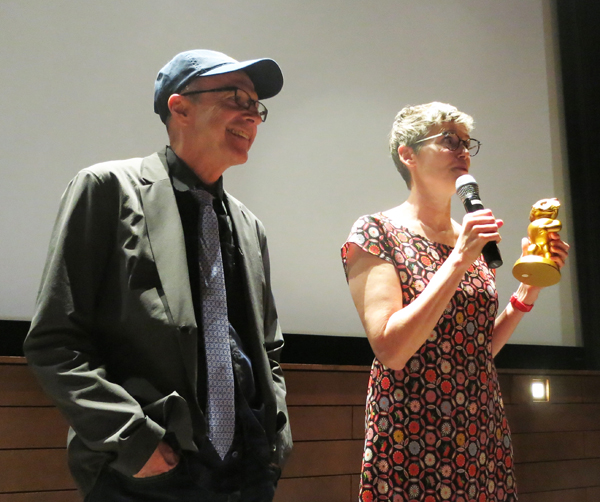
Kelley Conway awards J. J. Murphy a gilded Badger at the Communication Arts Showcase, 4 May 2019.
Posted in Actors, Film technique: Performance, Independent American film, People we like, Screenwriting, UW Film Studies |  open printable version
| Comments Off on Accident forgiveness: J.J. Murphy’s REWRITING INDIE CINEMA open printable version
| Comments Off on Accident forgiveness: J.J. Murphy’s REWRITING INDIE CINEMA
Sunday | April 28, 2019
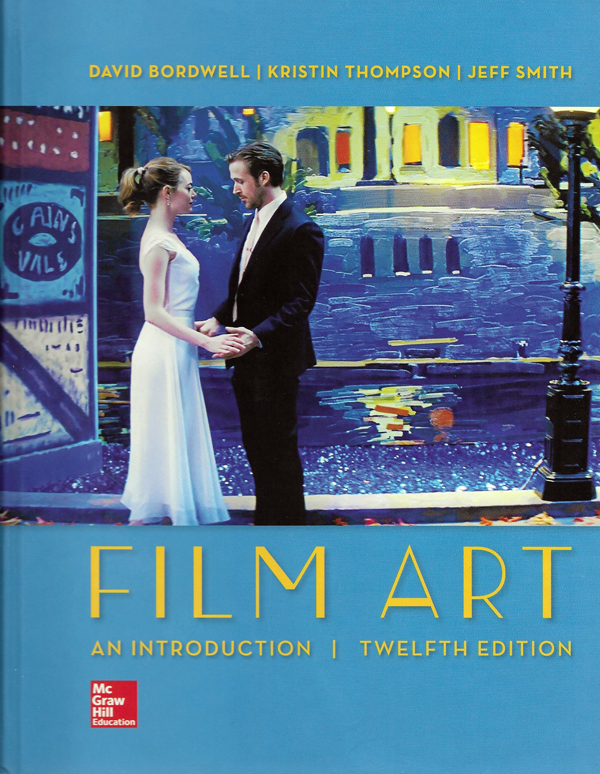
DB here:
The first edition of Film Art: An Introduction rolled into an unsuspecting world in 1979. Its butterscotch jacket enclosed 339 pages of text and black-and-white illustrations. It was, I think, the first film studies textbook to use frame enlargements instead of production stills. It was definitely the first to argue for a systematic aesthetic of cinema integrating principles of form (narrative/nonnarrative) with style (techniques of the medium). Our goal, of course, was to enhance the readers’ appreciation of the range and power of film as an art form.
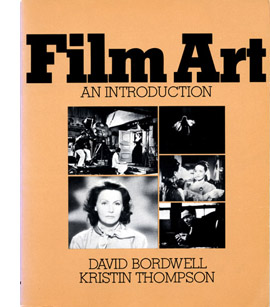 Not that there wasn’t a lot of room for improvement. Across three publishers–Addison-Wesley, then Knopf, and finally McGraw-Hill–the book has gained subtlety, precision, bulk, and color images. It now has a suite of online supplements in the form of aids for teachers and video clips for student reference, and the website you’re now visiting. Then there’s our streaming series on the Criterion Channel. Not that there wasn’t a lot of room for improvement. Across three publishers–Addison-Wesley, then Knopf, and finally McGraw-Hill–the book has gained subtlety, precision, bulk, and color images. It now has a suite of online supplements in the form of aids for teachers and video clips for student reference, and the website you’re now visiting. Then there’s our streaming series on the Criterion Channel.
The core of our efforts remain the ideas and information we explore in the text. That material, happy to say, has found support among teachers, scholars, and writers of other textbooks. Through their suggestions and criticisms, we’ve had four decades to refine what Kristin and I initially set out, and on the eleventh edition Jeff Smith joined us to make things even better.
What’s new about this twelfth edition? Of course, we’ve updated it. We incorporate examples from Get Out, Son of Saul, mother!, Moonlight, Guardians of the Galaxy, Tiny Furniture, Inside Man, Wonderstruck, Dunkirk, Fences, Manchester by the Sea, Baby Driver, The Big Sick, Hell or High Water, Hostiles, A Girl Walks Home Alone at Night, The Blind Side, Opéra Mouffe, My Life as a Zucchini, Kubo and the Two Strings, Lady Bird, Birdman, The Lost World: Jurassic Park, Tangerine, A Ghost Story, Snowpiercer, The Grand Budapest Hotel, and other recent titles.
One of the biggest changes involves the addition of an analysis of social and political ideology in Ali: Fear Eats the Soul. This detailed look at Fassbinder’s melodrama of prejudice replaces our study of masculinity and violence in Raging Bull. That earlier piece will be posted for free access on this site, joining analyses from earlier editions on this page.
The most evident difference, signaled on the cover you see above, is a new case study of how a film gets made.
Production: The hows and whys
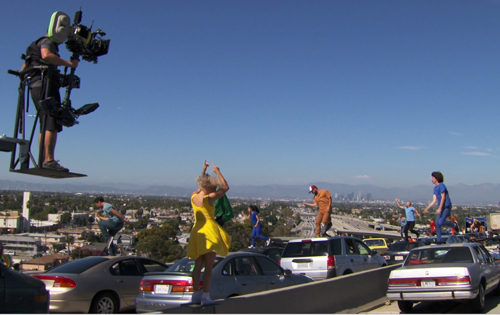
The book’s opening chapter,”Film as Art: Creativity, Technology, and Business,” matters a lot to us. We try to provide concrete, systematically organized information about how people work with technology and within institutions to implement the techniques we’ll survey in later chapters. At the same time, our discussion of production, distribution, and exhibition tries to show how filmmaking institutions shape creative choices about form and style. Perhaps because we try to make those choices down-to-earth, we’ve been pleased to find that Film Art is used in film production courses.
For several editions, Michael Mann’s Collateral served us well as a model of how decision-making in the production process shaped the final film. We thought, however, it was time to refresh that chapter, and La La Land provided us rich opportunities. We had already written blog entries (here and here) about aspects of the film, but we wanted learn more about how it had been created.
Made by a director not much older than our students, La La Land was perfect for a book that tries to be both up-to-date and sensitive to film history. From the burst of ensemble energy in the opening traffic jam to the parallel-reality ballet at the end, Damien Chazelle’s film was both contemporary and classical, what Kristin calls “a modern, old-fashioned musical.” We thought it would help students see that a young filmmaker can draw on tradition while staying firmly in our moment.
The film’s production decisions were well-documented, so we were able to trace four areas of creative choice. By considering the film’s mise-en-scene, camerawork, editing, and sound, we could set up the major stylistic categories to come in later chapters. For example, Jeff could point out unique features of Justin Hurwitz’s score.
We were lucky to get guidance from Damien himself. He reviewed our analysis, and then went far beyond the call of duty. He came to Madison to talk with our students (chronicled here). He sat for interviews with the Criterion Channel on Jean Rouch and Maurice Pialat. He did three Q & A’s. He even took snapshots with his fans.
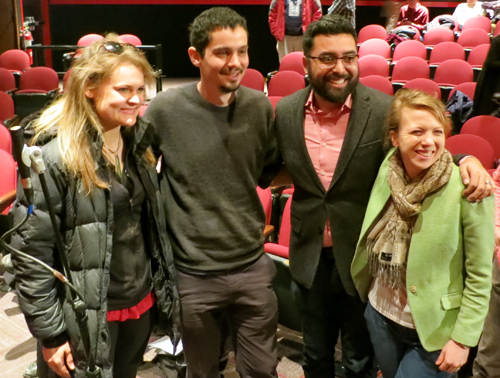
And Damien energetically helped us secure rights to the cover image, a process that all writers of film books approach with fear and trembling. In short, he proved a total mensch. The fact that he had already read our work when we first contacted him encouraged us in the belief that we might be helping young filmmakers find their way.
Film Art wherever you go
Film Art is now available in a variety of formats and prices. The print edition is now a looseleaf, unbound one. Bound copies still circulate for rental. Students may also rent or buy the e-book edition, which comes packaged as a digital resource called Connect. It’s possible to merge some of these alternatives. The various options for getting the book are charted here.
The Connect package includes teaching aids for the instructor (self-tests, quizzes) and access to thirty-six film extracts, courtesy of the Criterion and Janus companies. There are also four fine videos on production practice by our colleague Erik Gunneson.
As I discussed at exhausting length when I previewed our new edition of Film History: An Introduction, the variety of formats for the book reflects not only changes in technology and the publishing market but also changes in consumer preferences.
However it’s accessed, Film Art: An Introduction still makes us happy. We’ve tried our hardest to help readers understand a bit more about the techniques and effects of cinema. As we point out in the book, thanks to smartphones everybody is a filmmaker now. We think that students’ hands-on experience prepares them for our efforts to understand the creative choices filmmakers have faced from the very beginning.
Thanks as ever to the staff at McGraw-Hill: our editor Sarah Remington and the team consisting of Danielle Clement, Sue Culbertson, Maryellen Curley, Joni Fraser, Ann Marie Jannett, and Elizabeth Murphy. Thanks as well to Kaitlin Fyfe and Erik Gunneson here at the Department of Communication Arts, UW–Madison. And of course thanks to Peter Becker, Kim Hendrickson, and their colleagues at Criterion.
Instructors who want to learn more about this edition can find a McGraw-Hill representative here.
Jeff Smith, who wrote the analysis of Ali: Fear Eats the Soul for our book, also provided an incisive discussion of staging in the film for our series on the Criterion Channel.
There’s a fuller account of how we came to write Film Art in our announcement of the previous edition.
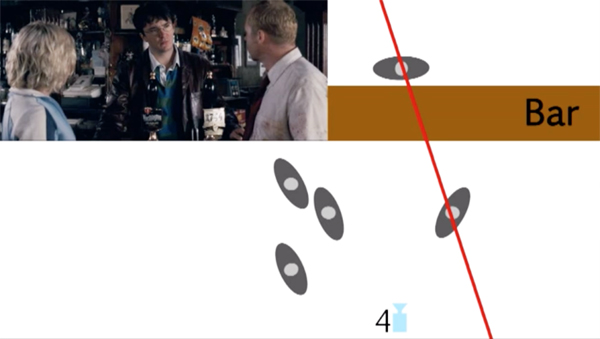
Video supplement: Shifting the Axis of Action in Shaun of the Dead.
Posted in Directors: Chazelle, FILM ART (the book), Film comments, People we like |  open printable version
| Comments Off on Frisky at forty: FILM ART, 12th edition open printable version
| Comments Off on Frisky at forty: FILM ART, 12th edition
Tuesday | April 23, 2019
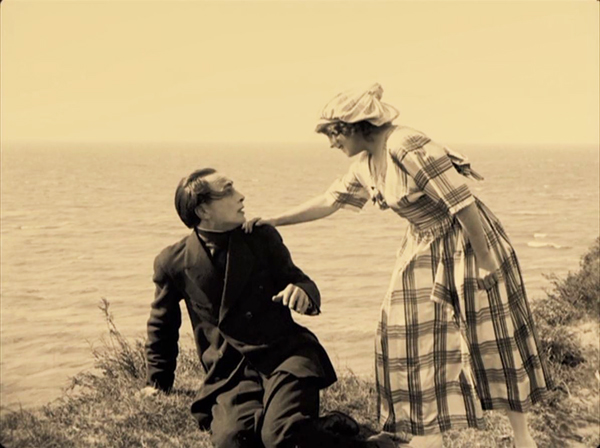
Der Gang in die Nacht (1921).
Kristin here:
Back in 2016, the Munich Film Archive gave us a preview of the restored version of F. W. Murnau’s earliest surviving film, Der Gang in die Nacht (1921). The print was splendid, and David posted an entry in which he analyzed the film’s style and situated it in the context of German cinema in the early post-World War I years. He tied the film to the tableau style that developed in much of the world outside the USA during the 1910s and which began to adjust to Hollywood norms of continuity editing just when Murnau was making films like Der Gang in die Nacht.
In that entry he used several frames from the restoration, and a glance over it will show its spectacular visual quality. I won’t spend much time on that film here, since David covered it so thoroughly. He wrote, “We can hope that the film will soon appear on DVD. Remember DVDs?” He and I certainly do. The Edition Filmmuseum obviously does as well. They continue to release their restorations and collections of more recent experimental films solely on DVD. Maybe Blu-rays are simply too expensive to produce, or perhaps the staff there consider Blu-rays a passing fad, like talkies. At any rate, this DVD release looks great (see above). it can easily be ordered from the Edition Filmmuseum’s shop (English page).
Apart from the tableau staging and the proto-continuity cut-ins that David discusses, there are some impressive depth shots–involving, as often happens in 1910s films, spectators in a theater box with the stage in the distance.
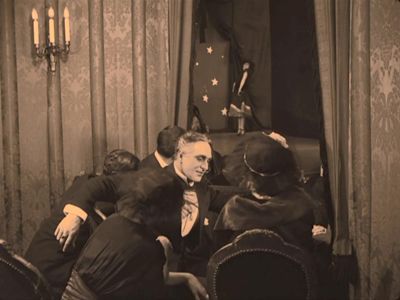
The film was restored from the original camera negative, though negatives were not edited in the final form of the film. By studying Murnau’s shooting script and restoration work previously done by Enno Patalas, the team were able to reconstruct the films’s editing and intertitles. The tinting and toning are based on the conventions of the period and are thoroughly plausible. David’s remarks in his earlier post are condensed slightly into this still applicable summary quoted in Stefan Drössler’s notes on the film:
The Munich Film Museum’s team has created one of the most beautiful editions of a silent film I’ve ever seen. You look at these shots and realize that most versions of silent films are deeply unfaithful to what early audiences saw. In those days, the camera negative was usually the printing negative, so what was recorded got onto the screen. The new Munich restoration allows you to see everything in the frame, with a marvelous translucence and density of detail. Forget High Frame Rate: This is hypnotic, immersive cinema.
The DVD lives up to that description.
A 1921 double feature
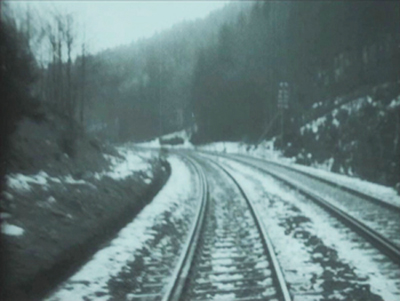
Without much fanfare, this release also contains another major classic of 1921, Scherben (“Shattered” or more literally “Fragments”). Its director, Lupu Pick, is probably best known today from his performance as the tragic Japanese spy, Dr. Masimoto, in Fritz Lang’s Spione (1928). He was, however, a prolific director from 1918 to 1931. (His acting career lasted from 1910 to 1928.) Many of his films are apparently lost, though I have seen two: Mr. Wu (1918) and Das Panzergewölbe (1924), both good but conventional films.
As a director, however, he is best known for making two of the main films in the brief vogue for Kammerspiele: Scherben and Sylvester, or New Year’s Eve (1923). These two films were scripted by Carl Mayer, who, as Anton Kaes points out in the accompanying booklet, wrote all the German Kammerspiele films: Hintertreppe (1921, dir. Leopold Jessner), Sylvester, and Der letzte Mann (1924, dir. Murnau). One might add Carl Theodor Dreyer’s Michael (1924), shot in Germany and scripted by Thea von Harbau.
Mayer was all in favor of films with no intertitles–though in practice that meant almost none. Der letzte Mann is one such, with an expository title introducing the sarcastic happy ending that Mayer was forced to add. Scherben is another. Near the end there is a single dialogue title. Moreover, Scherben’s subtitle is Ein deutsches Filmkammerspiel: Drama in fünf Tage. The five days are divided into the five reels of the film, and each is introduced by an expository title. There are a few letters and other texts that convey vital information, but overall the action is presented pictorially.
Scherben might be said to represent the slow cinema of its day. Its remarkable and lengthy opening shot is filmed from the front of a slowly moving train, simply showing progress along a track in a snowy landscape (above).
The main character (played by Werner Krauss, famous as Dr. Caligari) is a linesman, living with his wife and daughter in an isolated house. Their stultifying daily routine is gradually set up during the early scenes. Drama is introduced when a railroad inspector comes to visit, staying with the family. He and the daughter are immediately attracted to each other, spending a night together. The wife discovers this, staggers out into the snow to pray at a local shrine, and freezes to death. The tragedy deepens from there.
The film proceeds at the notoriously languid pace of German art films of the period. Pick injects stylistic flourishes derived from trends of the period. For some reason, the hallway of the family’s house has little Expressionistic painted highlights dotted around it.
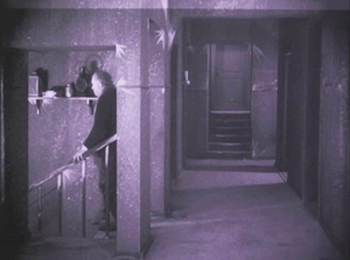
Werner Krauss often acts “with his back,” well before Emil Jannings was praised for doing so in the framing prison scenes of E. A. Dupont’s Variety (1925.)
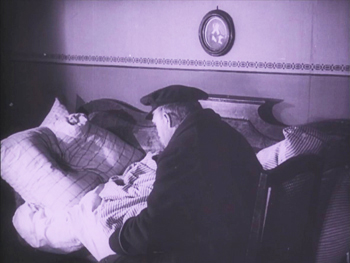
Pick calls upon the 1910s obsession with mirrors when the inspector reacts to accusations that he has seduced the linesman’s daughter.
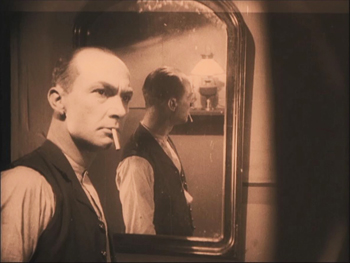
Pick also evokes the depth staging of the tableau style, with small areas of the screen glimpsed in the background, most notably in the scene where the mother discovers the lovers together. (See below.)
The print is not as spectacular as that of Der Gang in die Nacht, having been reconstructed from prints in the Gosfilmofond archive in Moscow and the Bundesarchiv in Berlin without extensive digital restoration. Still, we should be glad to have this milestone film available. Taken together, the two films make a welcome addition to the number of German classics available for home viewing and classroom use.
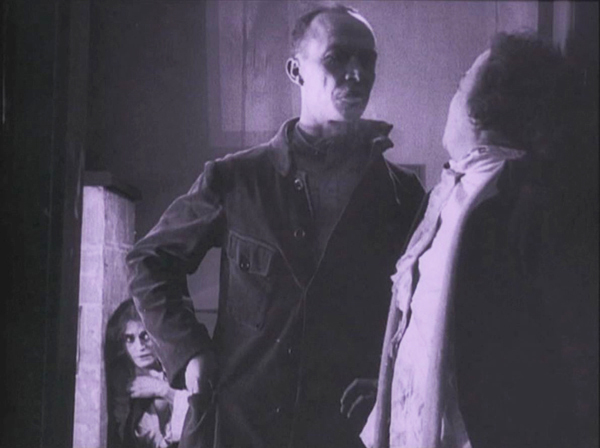
Scherben (1921).
Posted in 1910s cinema, Directors: Murnau, Film comments, National cinemas: Germany, Silent film, Tableau staging |  open printable version
| Comments Off on Two essential German silent classics from Edition Filmmuseum open printable version
| Comments Off on Two essential German silent classics from Edition Filmmuseum
Tuesday | April 16, 2019
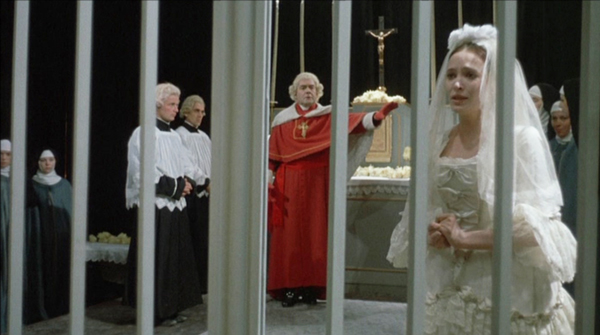
Suzanne Simonin, La religieuse de Denis Diderot (1966).
The Wisconsin Film Festival is over, and already we’re looking forward to the next one. In the meantime, here are our last thoughts on some films that impressed us.
Kristin here:
Dürrenmatt in Dakar
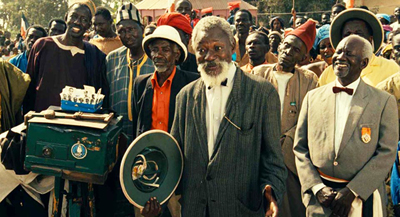
Hyenas (1992).
Senegalese director Djibril Diop Mambéty is known mostly for his two feature films, Touki Bouki (“The Hyena’s Journey,” 1973) and Hyenas (1992), and less so for a handful of shorts. Though unable to direct for long stretches of time, Mambéty, who died of cancer in 1998, has been well-served by preservationists. In 2013, Touki Bouki was released by the Criterion Collection in a box set of restorations by Martin Scorsese’s World Cinema Project. Now the Cinémathèque Suisse has sponsored a 4K restoration of Hyenas. As the echoes in the two titles suggests, Hyenas was intended to be the second film in a thematic trilogy about the corruption of ordinary people by greed. The third film, Malaika, was planned, but Mambéty’s early death intervened.
Hyenas is based on Swiss playwright Friedrich Dürrenmatt’s dark 1956 comedy, Der Besuch der alten Dame, known in English as The Visit. The film follows the story of the original fairly closely, at least in the play’s first two acts.
The action is set in the village of Colobane (Mambéty’s hometown, where Touki Bouki was also set). The village has fallen on hard economic times, and the genial local shopkeeper, Dramaan, helps keep the place going by extending credit to his regular customers. City officials announce the imminent arrival of Linguère Ramatou, a Colobane woman who left the village and has become extremely wealthy. Dramaan, who had courted Ramatou in their youth, is delegated to greet and butter her up (above). She, however, accuses him of having impregnated her and refused to confess to being her baby’s father. Forced to go abroad, she became a prostitute, was severely maimed in a plane crash, and ended up rich. (How is never explained). Now she promises the villagers great financial aid if they will agree to kill Dramaan.
Although the mayor indignantly refuses, Dramaan soon notices that his fellow citizens are buying luxurious goods that they should not be able to afford. He futilely tries to get local officials to protect him from assassination. All this is played for bitter comedy by an engaging cast of non-professionals. The thematic point is made clear, especially when Mambéty intercuts a pack of hyenas lurking in the nearby brush with a mob of locals who prevent Dramaan from fleeing the town.
It helps to know something about the setting, which would be familiar to Senegalese audiences. The film gives the impression that Colobane is a remote country village. In fact it is a small arrondissement of greater Dakar, a major port on the west coast of Senegal. In a lengthy overview of the director’s life, including an interview with Mambéty shortly before his death, N. Frank Ukadike explains:
The Colobane of Hyènes is a sad reminder of the economic disintegration, corruption, and consumer culture that has enveloped Africa since the 1960s. “We have sold our souls too cheaply,” Mambéty once said. “We are done for if we have traded our souls for money. That is why childhood is my last refuge.” But what remains of Colobane is not the magical childhood Mambéty pines for. In the last shot of Hyènes, a bulldozer erases the village from the face of the earth. A Senegalese viewer, one writer has claimed, “would know what rose in its place: the real-life Colobane, a notorious thieves’ market on the edge of Dakar.”
The last shot is startling, as it reveals for the first time (at least to non-Senegalese viewers) that Colobane is located right up against a city. Possibly in Mambéty’s childhood it was a village later absorbed by the spread of Dakar. It’s not clear from the film when the action is taking place, although Ukadike suggests that it must be in the 1960s or later. The implication of the final shot is that the corruption of the villagers is as much an urban problem as a rural one–if not more so.
The restoration has resulted in vibrantly colorful images that emphasize the indigenous costumes, particularly of Ramatou and her entourage (see bottom). Metrograph is releasing the film theatrically in the US, and with luck a Blu-ray will eventually make it more widely available.
David here:
Anomalies in the space-time continuum
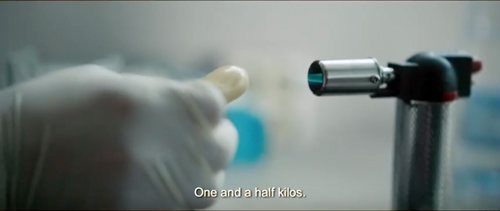
Vultures (2018).
Almost from the start, popular moviemaking has played tricks with linear time and space. Edwin S. Porter’s Life of an American Fireman (1903) contains both a dream and editing that replays key actions from two viewpoints. The more developed silent cinema explored flashbacks, subjective viewpoints, and other strategies. By the 1940s, filmmakers around the world were trying these tricks in sound movies, all seeking to enhance curiosity or suspense or surprise.
Most of the movies that play with space and time resolve the uncertainties clearly. The opening of Mildred Pierce skips over important moments without telling us, but by the end a flashback fills them in. This sort of gamesmanship has remained a permanent resource of mainstream cinema, especially in genres that rely on crime and mystery. Think of Pulp Fiction or Memento or The Usual Suspects, or more recently Identity, Side Effects, or the many heist movies that conceal crucial parts of the plan.
Börkur Sigpórsson’s debut feature Vultures is a good example of a conventional crime film made more intriguing by the way it’s told. The basic story is formulaic. An Icelandic real-estate developer needs to replace money he’s embezzled, and so sets up a drug-smuggling deal. He enlists his ex-con brother Atli to help the mule, a Serbian woman named Zonia, get through airport security. After that, Zonia has to be sequestered until she evacuates the pellets of cocaine she’s swallowed. In the meantime, Lena the policewoman gets on the trail. The whole scheme falls apart when Zonia collapses and Atli starts to take pity on her, while Erik decides to get the pellets by any means necessary.
This straightforward arc of action is presented in fragments that jump among time frames. Before the credits, we see Zonia hesitantly gulping down the pellets, getting sick on the flight into Reykjavík, and hiding in a toilet. She’s frightened when she hears a knock on the door.
Flash back to follow Atli and Erik planning the smuggling scheme. Then, via brief replays, we’re back with Zonia swallowing the pellets, Zonia on the plane (with Atli now revealed as a fellow passenger), and Zonia bolting to the toilet. He’s the one knocking on the door.
This sort of back-and-fill pattern sharpens our interest by delaying the revelation of who’s knocking on the door, while also filling us in on the brothers’ scheme. The interpolation also allots some sympathy to Atli. In the flashback he’s shown visiting his drug-devastated mother and trying to reassure his wife that he’s going to be providing for her and his son. Soon we see him distracting the airport police so that Zonia can pass through freely. The deal seems to have come off. All they have to do is retrieve the pellets.
Abruptly we skip far ahead in time to reveal a bit of the end of the story. I won’t provide a spoiler, but let’s just say that whatever certainty we gain about the outcome is provisional and partial. Still, with this small anchor in Now, the narration doubles back again through a long flashback that traces the unraveling of Erik’s scheme.
As often happens with flashback construction, the time-shifting in Vultures has a double impact. It teases us with hints about what will happen, and it forces us to concentrate on how and why it happens. (Something similar is at work in Duvivier’s Lydia, which I analyze in this month’s “Observations on Film Art” installment on the Criterion Channel.) Told more linearly, Vultures wouldn’t have been so engaging, I think. Nor would it have so sharply focused our concern about the characters’ decisions. And that crucial glimpse of the future allows us to hope that Zonia’s fate isn’t what it would have seemed to be if her story had been presented in 1-2-3 order. As usual, the how of storytelling is as important as the what.
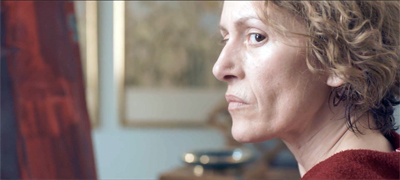
During the 1950s, films not only fractured their action in challenging ways but also refused to resolve all the questions that were raised. We might not fully understand everything that happened. This strategic ambiguity has been central to what’s sometimes called “art cinema,” and is nicely showcased in Pause, another debut feature. If Vultures plays hob with the crime movie, Cypriot director Tonia Mishiali gives us a jagged domestic drama, a diary of a going-mad housewife.
Elpida is falling apart. The darkly comic opening scene, with a doctor ticking off a virtually endless list of her ailments, portrays her as enervated and beaten-down. How she got that way becomes clear. Her husband Costas shovels in food in angry silence. He watches soccer on their main TV, while she has to watch her violent crime videos with headphones. He comes and goes as he pleases; she steals time to attend a painting class or have coffee with a neighbor. When he decides to sell her car without further discussion, and when a young contractor comes to repaint their apartment house, Elpida dares to imagine life without the lout she married.
Imagine is the key word. From her drab routines we pass without warning into fantasies of resistance, escape, and payback. At first, the visual narration makes clear that these acts of rebellion are wholly in her mind. As the film goes along, however, the boundary gets fuzzy. Is the breezy workman making a pass at her, or is she just wishing for it? Is she really drugging Costas’ coffee? And is murder in the offing?
The cinematography won’t tell us. Like Vultures, Pause presents its story through a now-standard blend of planimetric framings and a “free-camera” handheld style that suggests nervous urgency. The fantasies are treated through both techniques.
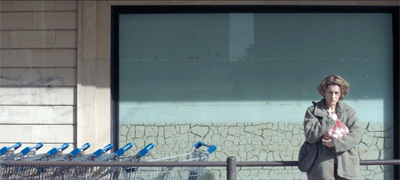 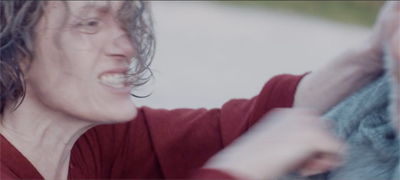
A woman’s domestic discontents, projected through fantasy, has been a mainstay of cinema since at least Germaine Dulac’s Smiling Madame Beudet (1923). Here, Mishiali’s careful pacing of Elpida’s household chores establishes a solid rhythm that’s broken by the imaginary moments. Like many modern films, the drama builds up by immersing us in the characters’ routines and then disturbing them with sudden outbursts. Yet the climax is remarkably quiet, further teasing us about what may or may not have happened. In any case, by the end, Elpida may be liberated. Yet her final laughter, echoing through the end credits, doesn’t feel especially jubilant.
Get thee from a nunnery
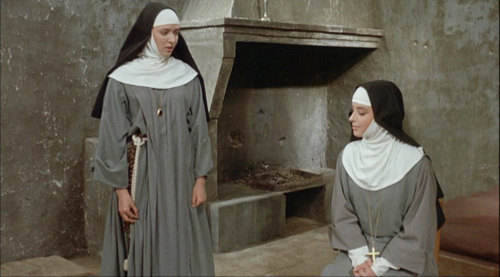
Suzanne Simonin, La religieuse de Denis Diderot was Jacques Rivette’s second feature. In 1962 he submitted a screenplay to censorship authorities but was told that if the film were made it would probably be banned. After another try in 1963, a third version was cautiously accepted, with the warning that it might well be forbidden to viewers under 18.
Shooting began in September of 1965. Catholic groups immediately objected. After a public outcry, in which Godard called on Minister of Culture André Malraux to intervene, there was a screening at the 1966 Cannes Film Festival. The film wasn’t released in France until July of 1967. Usually known as La religieuse (The Nun), it’s gone largely unseen in America. We were lucky to screen the sparkling 4K version that Rialto is now distributing.
The story is set in the years 1757-1760. Suzanne, illegitimate daughter of a prominent household, is parked in a convent, like many women who had no other life chances. Her first Mother Superior, who treats her with affection, dies and is succeeded by a harsh younger woman. Suzanne loves God but resists the rigid discipline. She’s beaten and starved, denied access to her Bible, and believed to be possessed.
She’s rescued by church officials and a kindly lawyer, who oversee her transfer to a very different convent. That’s run by a sexy, permissive Mother Superior who seems anxious to bed our heroine. Suzanne finds the license of her new home as disquieting as the asceticism of the old one. In the end, she escapes with a priest who abandons his vows. Soon she’s on her own in a grimy secular milieu.
No wonder the French church was outraged. True, Diderot’s novel was a classic, and Rivette had already mounted the story as a play. But on film the revelation of ecclesiastical corruption was vivid and shocking, and the presence of New Wave star Anna Karina gave it undeniable prestige. Popularity, too: It attracted more than 2.9 million spectators, making it the ninth most successful release of the year. (Films by Godard, Rohmer, Bresson, Bergman, and Chabrol drew fewer than half a million.) Rivette’s first feature, Paris nous appartient (1961) had drawn only about 29,000. As often happens, creating a scandal proved good for business.
Seen today, La religieuse is hard to imagine as a mass-audience hit. Rivette presents his inflammatory plot with a calm austerity. The dominant colors, at least for the first seventy minutes or so, are shades of beige, brown, white, and black. Shot in very long takes, usually at a distance from the action, the scenes are confined largely to chapels, corridors, and sparsely furnished rooms. La religieuse exemplifies what one wing of Cahiers du cinéma called “classical” direction. As a critic, Rivette admired Hawks, Preminger, Rossellini, the American Lang, and late Dreyer for their sober, unemphatic staging of performances. In place of flashy angles and aggressive cutting, mise-en-scène should center on expressive bodies and faces captured from a respectful distance.
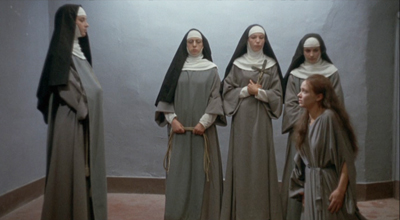
In a 1974 interview, Rivette explained that his most proximate influence was Mizoguchi Kenji–a director who made the restrained, long-take scene central to his style. While most scenes in La religieuse are cut up a little, Rivette seldom moves nearer than medium-shot distance. He uses close-ups with the same parsimony that Mizoguchi displays. Most directors would have cut in to a closer view of Suzanne when, kneeling, she’s asked to pray to Jesus, but Rivette obstinately makes her gesture part of a nearly two-minute shot.

This might seem a stagy approach, especially if you remember Rivette’s interest in varieties of theatre. But like other Cahiers critics, he believed that “classical” filmmaking harbored qualities that also kept cinema “modern,” on the aesthetic and moral edge.
In the abrupt editing of the long takes in Dreyer’s Gertrud (1964), Rivette found a revival of the powers of montage. Dreyer didn’t hesitate to interrupt moving shots. Rivette felt that the film exploited “tantalizing cuts, deliberately disturbing, which mean that the spectator is made to wonder where Gertrud ‘went’; well, she went in the splice.”
In La religieuse, most cuts within scenes are axial, not reverse angles, and they often mismatch action in ways that break the flow of the long takes.
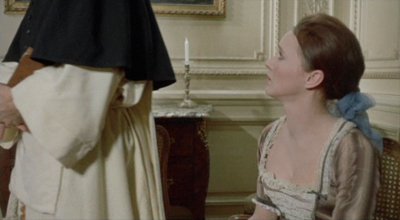 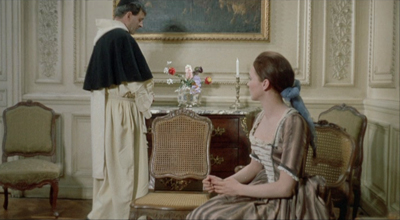
At other moments, Rivette’s editing subjects his distant shots to ellipses that recall Godard’s jump-cuts and Resnais’ experiments in Muriel. We get space-time anomalies more abrasive than those in Vultures and Pause.
Suzanne is in her cell, fretfully pacing. She pauses and, thanks to a cut, seems to look at herself at prayer.
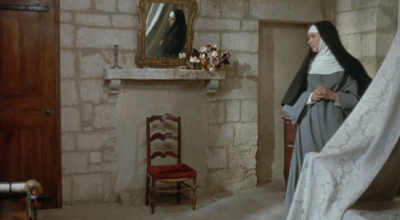 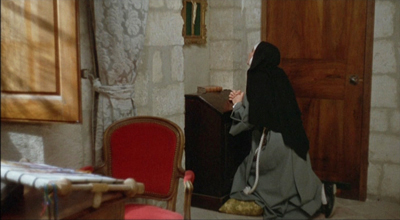
She drifts to her needlework, and suddenly a cut takes her back to the other side of the room.
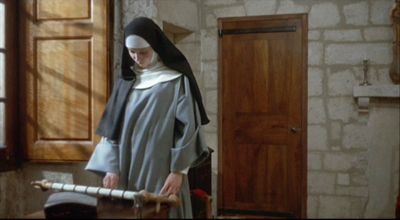 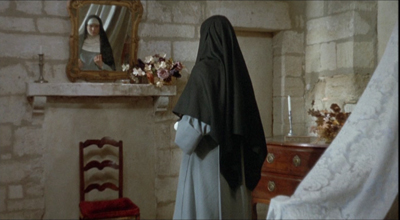
While she looks in the mirror, the camera backs up and, continuing over a cut, arcs to the right to reveal that she’s already flung herself onto her bed.
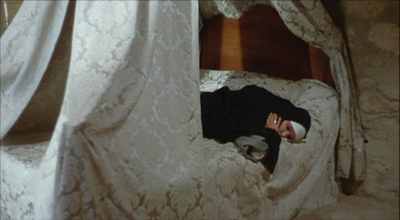
Where did Suzanne go? Well, she went in the splices.
It’s wonderful to have this quietly astonishing film available again. The ever-reliable Kino Lorber is bringing out a Blu-ray edition next month, with commentary by Nick Pinkerton, a critical essay by Dennis Lim, and a new documentary about the production. Don’t you want one? I bet you do.
Thanks as usual to the coordinators of our film festival–Jim Healy, Ben Reiser, Mike King, and Zach Zahos–as well as their colleagues and the hordes of cheerful volunteers who kept everything running smoothly.
The information about Colobane from N. Frank Ukadike is from his article on California Newsreel. For a trailer of the restored Hyenas, see here.
The information on La Religieuse‘s censorship struggles comes from Jean-Michel Frodon, L’Âge moderne du cinéma français: De la Nouvelle Vague à nos jours (Flammarion, 1995), 149-151. Rivette’s comments on Mizoguchi’s influence are in this Film Comment interview from 1974. His remarks on Gertrud are part of a 1969 Cahiers du cinéma panel discussion, “Montage,” translated in Rivette: Texts and Interviews, ed. Jonathan Rosenbaum (British Film Institute, 1977), 86-87. The conversation is available online at DVDBeaver. I derived attendance figures from Simon Simsi, Ciné-Passions: 7e art et industrie de 1945 à 2000 (Dixit/CNC, 2000), 46-47.
What’s an axial cut? Glad you asked. Kurosawa uses them (here too), as does Eisenstein and his Soviet peers and French avant-gardists. Silent cinema has plenty, but so do the films of Wes Anderson and John McTiernan. And The Simpsons, often.
Our first full day of the festival opened with a screening of Ozu’s Good Morning (Ohayo), selected by guest Phil Johnston, and the final show a week later presented Jackie Chan’s Police Story. (The first is already available in a Criterion disc, the second is coming soon.) Now that’s what I call a film festival.
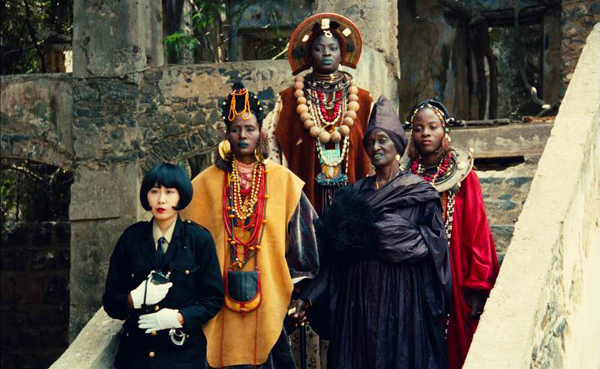
Hyenas (1992).
Posted in Directors: Rivette, Film comments, Film technique: Editing, Film technique: Staging, Narrative strategies, National cinemas: Africa, National cinemas: France |  open printable version
| Comments Off on Wisconsin Film Festival: Four for the road open printable version
| Comments Off on Wisconsin Film Festival: Four for the road
|
 I couldn’t have predicted that J. J., who was in grad school with Kristin and me, would turn to research. He began as part of the Structural Film movement, achieving wide renown with Print Generation (1974) and (my personal favorite) Sky Blue Water Light Sign (1972). After he was hired here at Wisconsin, he rejuvenated our production program and went on to make independent features: The Night Belongs to the Police (1982), Terminal Disorder (1983), Frame of Mind (1985), and Horicon (1994).
I couldn’t have predicted that J. J., who was in grad school with Kristin and me, would turn to research. He began as part of the Structural Film movement, achieving wide renown with Print Generation (1974) and (my personal favorite) Sky Blue Water Light Sign (1972). After he was hired here at Wisconsin, he rejuvenated our production program and went on to make independent features: The Night Belongs to the Police (1982), Terminal Disorder (1983), Frame of Mind (1985), and Horicon (1994).

